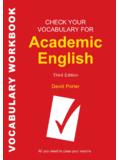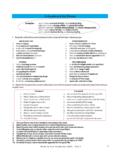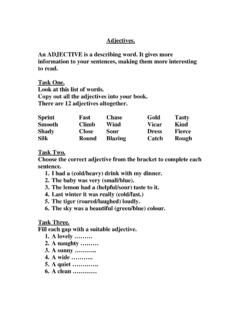Transcription of Please cut the individual letter cards and tricky …
1 Task while you wait: Please cut the individual letter cards and tricky words found in your handouts and place them in the snap lock bag provided. Understanding Synthetic Phonics through Presenter Santina DiMauro Jolly Phonics is a multi-sensory program which caters for children with varying capabilities. It has scientific research based evidence to support its method and has been adopted throughout the world.
2 International Research reading yrs ahead of chronological age spelling yrs ahead of chronological age comprehension months ahead boys reading months ahead of girls boys spelling months ahead of girls Clackmannanshire Research A seven year study Research The Jolly Phonics children s reading skills were 11 months above the level expected for their age The synthetic phonics classes outperformed the whole language classes on 16 out of 19 reading and spelling measures The results demonstrated that Jolly Phonics produced effects that were long-lasting Jolly Phonics is a synthetic phonics program which helps children to use the sounds of the English language for reading and writing.
3 Synthetic Phonics A part to whole approach to reading. The alphabetic code is taught before expecting children to read books. Teaches blending and segmenting using alphabetic letter sounds and main digraphs. Synthetic Phonics Teaches phonemic awareness so that all sounds in words can be identified: cat is c-a-t; bus is b-u-s; stop is s-t-o-p, Teaches main digraphs with blending and segmenting. Teaches tricky words learning about tricky parts of words. Synthetic Phonics Use decodable texts initially. Other books given when there is fluency and an ability to work out unknown words.
4 Blending used as the first strategy for unknown words. Analytic Phonics A whole to part approach. A top down approach to reading. Begins with whole word sight vocabulary and reading books. Uses picture, initial letter and contextual cues for word recognition. Analytic Phonics Uses text that is picture gives clue for the new word introduced on the page. Alphabet letter sounds are introduced to enable the initial letter cue for word recognition. Digraphs are rarely taught. Analytic Phonics Key sight words are memorised visually.
5 Blending used at the last strategy instead of the first. Word patterns covered at a later stage. car Understanding Synthetic Phonics truck Understanding Synthetic Phonics worm Understanding Synthetic Phonics rainbow Understanding Synthetic Phonics spray Understanding Synthetic Phonics wombat Understanding Synthetic Phonics cube Understanding Synthetic Phonics little Understanding Synthetic Phonics fox Understanding Synthetic Phonics Learning the letter Sounds letter Formation Blending and Segmenting Identifying Sounds in Words tricky Words The Five Skills of Jolly Phonics Children are taught the main 42 letter sounds (not just the)
6 Sounds of the alphabet). Later they learn the alternative spellings of some sounds (eg ay, a-e, ai) Learning the letter Sounds The 42 Sounds Learning the letter sounds letter Sounds Songs and Puppets Each sound is explored with an action Each sound is introduced with a story. Tactile work with play dough, Finger Phonics Children are taught letter formation through a tactile approach: play dough Finger Phonics Air writing Pencil work letter Formation Children are taught letter formation through a tactile approach: Hair Gel Tactile Bags Sandpaper Letters Tactile Paint Table Interactive Whiteboard letter Formation Children are taught to blend sounds together to read new words.
7 Children are taught to segment words to write words. Blending and Segmenting Listening for sounds in words gives children the best start for reading and writing. Children tune into sounds anywhere in words. Children learn that words are made up of a sequence of sounds. Identifying Sounds in Words These are words that have irregular spellings. Jolly Phonics introduces children to 60 common words that are irregular. tricky Words tricky Words Adapted tricky List Reading: Memory recall of words. Say it as it sounds. Writing: - look, cover, write and check - Mnemonics tricky Words tricky Words Foundation to reading and spelling It is a prerequisite skill before children can learn to associate sounds with letters and manipulate sounds to blend words (during reading) or segment words (during spelling).
8 Listening to sounds in sequence. Clapping and counting sounds in words: c - a - t b - ir - d h - ou - se x x x x x x x x x Listening to sounds anywhere in words. Playing around with sounds. Blending and segmenting sounds in words Understanding sounds in Understanding sounds in Guess My Picture This activity helps children develop blending without the visual picture cue. Teaching Jolly Phonics Words Banks Sound Exploration Blending Activities Miming: children use actions and segment a word for others to blend (segmenting and blending activity) Pointing to letter symbols on board.
9 Children blend sounds and say whole word. Read and See Books Sound Flip cards Blending and Segmenting Activities Miming: using actions to create a word. It helps children with both blending and segmenting skills. p ar k ..park After the first group of six sounds, the children can blend sounds to read approximately 43 words. Word Banks - Blending As a new sound is introduced more words can be made by blending the sounds together. Begin with simple words of two, three and four sounds. Increase the level of difficulty as the children become better at blending and segmenting.
10 Blending Activities Pointing to letters one by one. h a p t n s i f Read and See Books Blending Activities Blending Activities Identifying Sounds in Words Flips can help children with: - blending - segmenting - specific sounds - beginning, middle and end sounds What we should be doing after group 1? Play games to encourage the skill of blending. Use the actions to create words. Point to sound symbols for children to blend together. Read simple words of two, three or four sounds.





